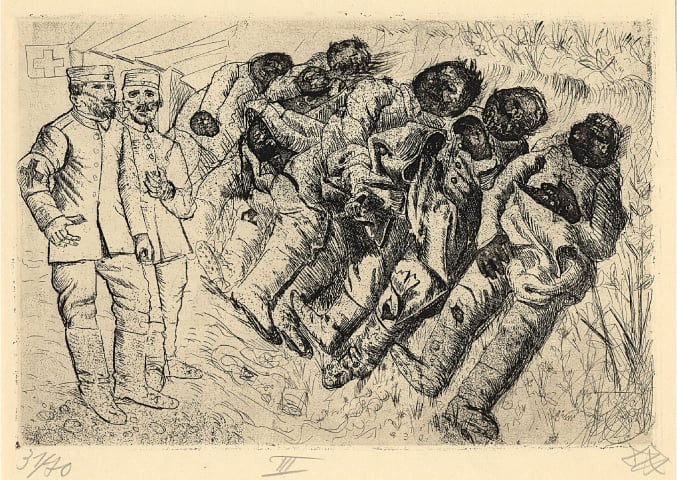
A walk through the Otto Dix — War and Social Criticism exhibition at the VM Gallery in Karachi is a chilling experience. The horrors of the two World Wars are captured with such acute immediacy that one is forced to reflect on the strangeness of the human temperament. Other than a war chronicle, Dix’s series is a telling illustration of human propensity to violate and ravage their own kind relentlessly.
Dix, an artillery gunner in the trenches from 1914 to 1918, experienced live combat on both the Eastern and Western fronts. Appearing 10 years after the conflict began, Dix’s monumental portfolio Der Krieg (The War) speaks of the intensity of that experience and how it haunted him till he released it from the shackles of memory into the corrosive nature of etching and aquatint — mediums in which acid etches a metal printing plate. Initially drawn to Expressionism and Dadaism, the artist like many of his generation in Germany in the 1920s, was inspired by trends in Italy and France to embrace a cold, linear style of drawing and more realistic imagery.
His unflinching narrative of battle, death and decay focused not just on prints of crippled shell-shocked soldiers, decomposing bodies and bombed-out landscapes, but also spanned a society damaged — both physically and morally — by the horrors of war. He painted savagely satirical portraits of celebrities from Germany’s intellectual circles but his main focus was on the helpless and the marginalised. Extreme caricature and purposely grotesque imagery as well as adept manipulation of etching and aquatint mediums heightened the emotional and realistic effects of his portraiture of urban decay, prostitution and the destructive power of sex.
German artist Otto Dix’s epic series is a gruesome and brutally honest depiction of war
If history has lessons to impart, they can be found in ghoulish images of soldiers lurching forward in gas masks, worms invading the empty eye sockets of a skull, a helmeted sentry still proudly on guard, even though he is no more than a skeleton crawling with maggots, collapsed trenches, carcasses of animals, gas victims darkened by lack of oxygen and more of the same among the 50 unrelentingly graphic images of the War series.
Dix exposed the effects of industrialised warfare on the body during a time when the government and the army sought to conceal these effects. Unlike the idealised images of soldier-hood proliferated throughout the 1920s, this epic series of 50 intaglios is raw, gruesome and brutally honest and is comparable to Goya’s ‘The Disasters Of War’, such is its strength and sentiment.

For Dix, his work was a catharsis but he doubted if his prints would have any bearing on future wars. His publisher in Berlin, Karl Nierendorf, circulated the portfolio throughout Germany through the help of a pacifist organisation, “Never Again War.” Despite the intensive publicity, Nierendorf sold only one complete portfolio from the edition of 70. It seems that power lobbies do not want to be confronted with the truth that surrounds the devastation they perpetrate.
“Otto Dix — War and Social Criticism” was exhibited at the VM Gallery in Karachi from November 22 to December 19, 2018
Published in Dawn, EOS, December 23rd, 2018













































Dear visitor, the comments section is undergoing an overhaul and will return soon.